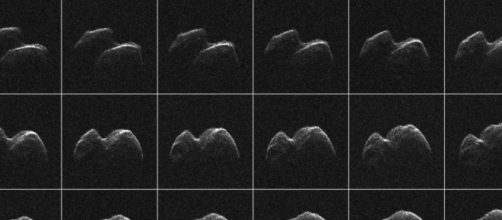On April 19, the National Aeronautics and Space Administration (NASA) observed a large asteroid called 2014 JO25 that was within 4.6 lunar distances of the Earth, which is the closest approach by an asteroid of its size since 4179 Toutatis in September 2004. The agency released the images of the asteroid on Friday, revealing its extremely unique shape that has been said to resemble a lopsided peanut, or a "rubber ducky," depending on the viewing angle.
An irregular and deeply bifurcated asteroid
2014 JO25 was first discovered near Tucson, Arizona, in May 2014 by Al Grauer of the Catalina Sky Survey (CSS), a project of NASA's Near-Earth Object [NEO] Observations Program.
The initial discovery by a member of the NEOWISE science team revealed the size of the asteroid to be 650 meters or 2,000 feet with an optical albedo of 0.25, which is twice as reflective as our Earth's Moon. During the time the bright asteroid was in the closest distance from Earth, between April 19 and 25, NASA performed radar observations at the National Science Foundation's Arecibo Observatory and at NASA's Goldstone Solar System Radar.
Lopsided peanut or rubber ducky asteroid?
According to NASA, the observations resulted in hundreds of high-resolution images that confirmed the size estimate of 2014 JO25. These images, obtained from Arecibo and Goldstone, showed that the asteroid has two major components that are connected by a relatively narrow neck.
Scientists aren't sure how the asteroid got its shape, but NASA suggests that it might be due to a slow collision between two separate objects or due to the planetary tides pulling it apart as 2014 JO25 approaches Mercury or Earth. The overall shape is also similar to another rubber duck-shaped nucleus of the now famous Comet 67P/Churyumov-Garasimenko, which was recently explored, and found to be more than four times larger than our 2014 JO25.
Using the measurements obtained during the observation period, scientists have estimated that the roughness of 2014 JO25 is similar to the previous estimation provided for asteroids 433 Eros, 25143 Itokawa, and 4179 Toutatis. Although the asteroid will not be this close again for more than 400 years, the detailed measurement obtained allows for thousands of years of computation.
Using the estimate, the radar albedo of the asteroid is likely to be about 0.2, consistent with a rocky composition. Using a SpeX instrument, it is known that the asteroid has 1 and 2 microns absorption features, consistent with an S-type asteroid.


